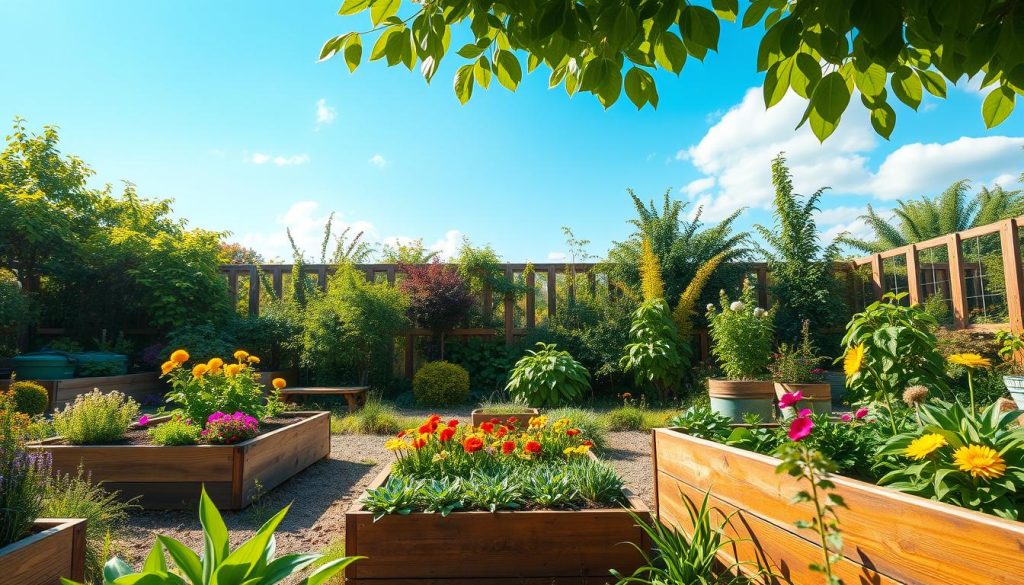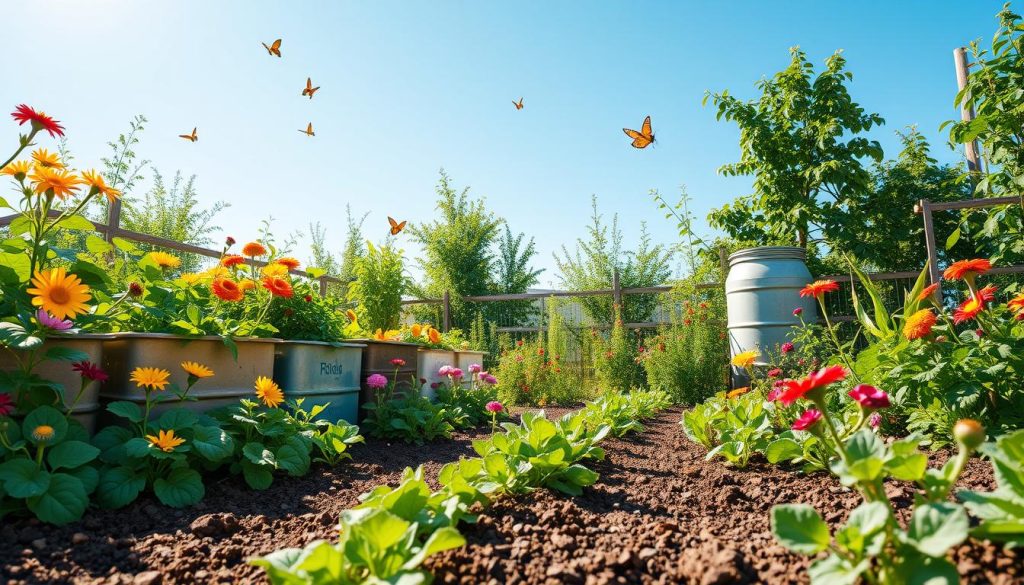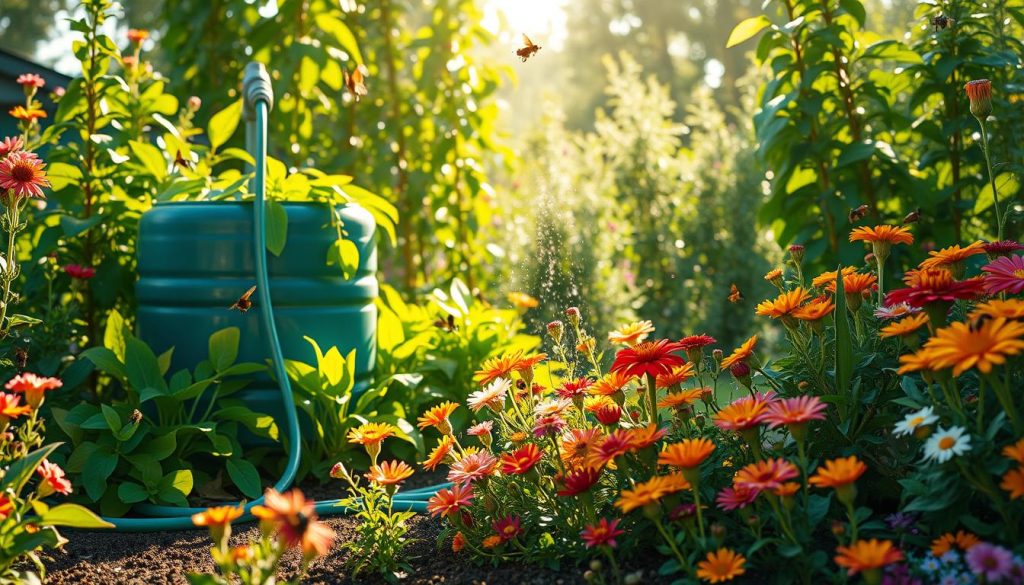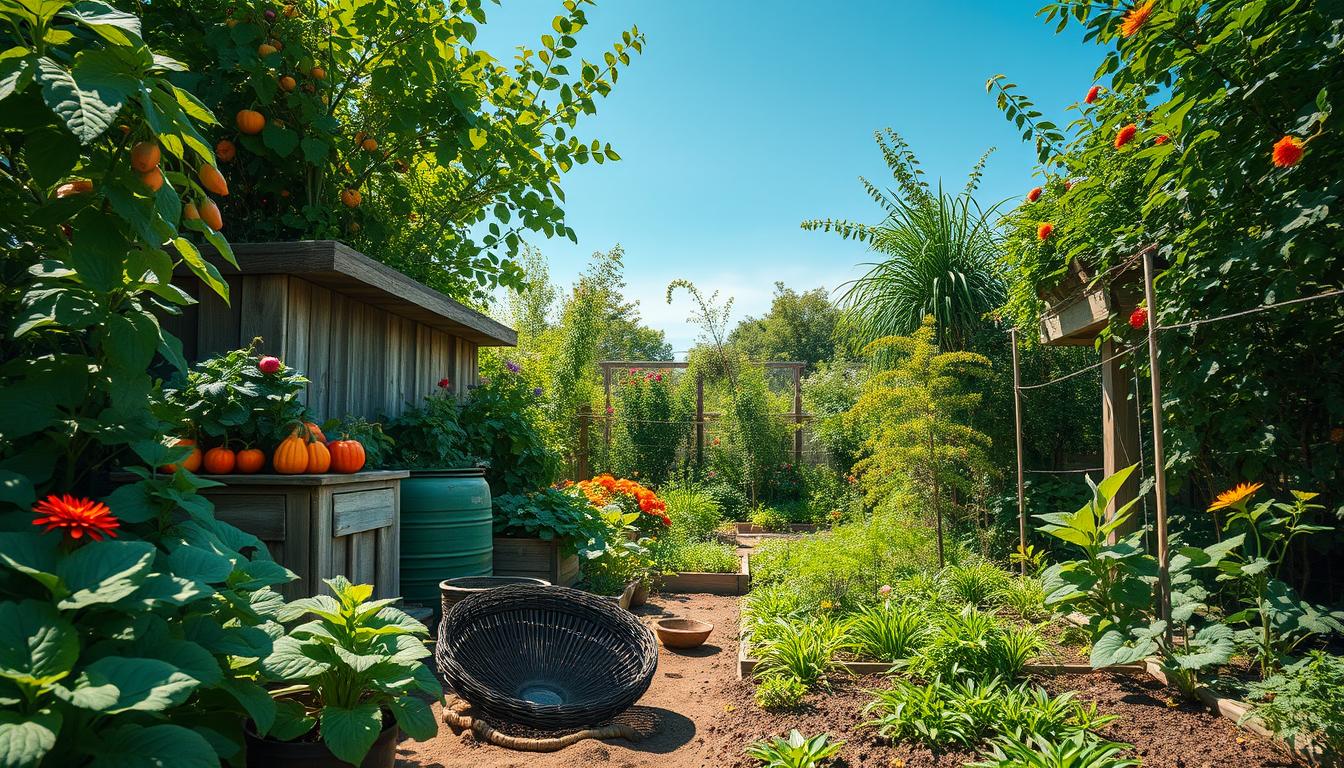I’m excited to share my summer gardening tips for a zero-waste garden. It’s all about using sustainable practices to reduce waste. By doing so, we can enjoy growing our own food and help the environment.
Learning sustainable gardening practices is crucial for a zero-waste garden. This includes planning, soil care, pest control, and harvesting. In this article, I’ll guide you on how to create a sustainable garden using eco-friendly methods.
Understanding Zero-Waste Gardening Concepts
Exploring zero-waste gardening is exciting. It’s all about cutting down waste and making gardening better for the planet. By using organic methods, we can make our gardens healthier and more eco-friendly. Composting and using natural stuff helps a lot in reducing waste.
Key zero-waste gardening ideas include using rainwater and avoiding harmful chemicals. These steps not only cut down waste but also save water and improve our surroundings. By following these ideas, we can greatly help the environment.
- Conserving water through efficient irrigation systems
- Reducing the use of chemical pesticides and fertilizers
- Creating a healthier and more sustainable garden ecosystem
- Reducing garden waste through composting and recycling
Zero-waste gardening helps us garden in a greener way. It’s a step towards making our planet a better place.
Planning Your Garden Layout
When planning my garden, I focus on eco-friendly tips. I pick a spot that gets enough sunlight, has good soil, and is easy to get to. This way, my garden will look great and need little care.
Companion planting is a green practice I love. It means growing different plants together to help each other grow. For instance, marigolds keep nematodes away from tomatoes. Basil and mint make veggies taste better. This method makes my garden a balanced, eco-friendly place.

I also choose native plants for my garden. They fit our local weather and need less care. This choice cuts down on the need for fertilizers, pesticides, and water. My top picks are coneflowers, black-eyed susans, and lavender. They draw in pollinators and make my garden stunning.
- Choose native plants to reduce maintenance and environmental impact
- Incorporate companion planting to improve growth and biodiversity
- Consider sunlight, soil quality, and accessibility when selecting a garden space
By using these eco-friendly tips, my garden becomes a lush, green space. It’s good for me and the planet.
Sustainable Soil Management
As I continue my summer gardening with zero waste journey, I’ve learned the importance of sustainable soil management. It’s not just about cutting down trash. It’s also about making my garden healthy and thriving. Composting kitchen scraps and using mulch to save water are key.
These practices help my soil hold water better and grow beneficial microbes. This reduces my environmental footprint and makes my garden more sustainable. Some benefits include:
- Improved soil fertility and structure
- Increased water-holding capacity, reducing the need for frequent watering
- Support for beneficial microorganisms, which helps to break down organic matter and fight plant diseases
To start, compost kitchen scraps and use mulch to save water. These simple steps can greatly reduce waste and make my garden healthier. 
Composting Kitchen Scraps for Fertilizer
Composting kitchen scraps is a smart way to make natural fertilizer and cut down on waste. Adding compost to the soil improves its structure and supports beneficial microbes.
Utilizing Mulch to Conserve Moisture
Using mulch is also effective for saving water, controlling weeds, and keeping soil temperature right. These practices help me reduce my environmental impact and create a sustainable garden for summer gardening with zero waste.
Watering Wisely
As I share eco-friendly garden tips, I stress the need for wise watering. This is key in sustainable gardening, cutting down waste and saving water. A few simple steps can make your watering system more efficient and green.
Harvesting rainwater is a great way to save water. You can set up a rainwater collection system, from a simple barrel to a big tank. This water can then water your plants, saving municipal water and cutting down your bills.
Rainwater Harvesting Techniques
- Install a rainwater collection system to collect and store rainwater
- Use a first flush device to divert debris and contaminants from the roof
- Connect the collected water to a drip irrigation system for efficient watering
Drip irrigation is also a green choice for watering. It sends water straight to plant roots, cutting down on evaporation and runoff. This means your plants get the water they need without wasting it.

Drip Irrigation vs. Traditional Watering
Drip irrigation beats traditional watering in many ways. It can cut water use by up to 50%. This makes it a vital part of green gardening.
Pest Control Without Chemicals
Exploring organic gardening, I’ve learned the value of pest control without chemicals. Using eco-friendly gardening methods helps us avoid chemical pesticides. This way, we make our gardens more sustainable. Attracting beneficial insects like bees and butterflies is key. They pollinate plants and naturally control pests.
To draw in these helpful insects, we can plant a variety of flowers, herbs, and veggies. We also need to provide water for them. This method not only fights pests but also boosts the local ecosystem. Plus, homemade organic pest solutions like neem oil and garlic spray work well without harming the environment.
Attracting Beneficial Insects
- Plant a diverse range of flowers, herbs, and vegetables to attract beneficial insects
- Provide a source of water, such as a birdbath or shallow dish, for beneficial insects
- Avoid using chemical pesticides, which can harm beneficial insects and the environment
Homemade Organic Pest Solutions
Homemade organic pest solutions are great for controlling pests without harming the planet. Neem oil, garlic spray, and soap solution are some effective options. These can be made at home using natural ingredients. They can be applied directly to plants to keep pests away.
Harvesting and Storing Produce
As I keep up with green gardening, I’ve learned how key harvesting and storing are. It helps me enjoy my garden’s bounty longer and cuts down on waste. To do this right, I check if my produce is ripe and ready.
It’s vital to cut down on garden waste for sustainable gardening. Simple steps can make a big difference. For example, picking produce in the morning keeps it fresh. Also, using the right tools makes harvesting better.
Practical Tips for Harvesting and Storing
- Check for ripeness: Regularly inspect your plants for signs of ripeness, such as color, texture, and scent.
- Harvest in the morning: Harvesting in the morning helps reduce moisture loss and ensures optimal freshness.
- Use the right tools: Invest in a good pair of gardening shears or a harvest knife to make the process easier and more efficient.
By following these tips, I can cut down on waste and get more from my garden. Preserving extra produce through fermenting and drying also helps. It keeps fruits and veggies fresh longer, so I can enjoy them for weeks.
Sharing and Community Involvement
Zero-waste gardening doesn’t have to be done alone. You can join forces with your local community. This way, you can share knowledge, resources, and garden produce. Organizing a plant swap in your neighborhood is a great way to start.
Organizing a Plant Swap in Your Neighborhood
Plant swaps let you exchange seeds, seedlings, and plants with other gardeners. It’s a win-win for everyone, as it diversifies your garden and reduces waste. Just invite your neighbors, local gardening clubs, or community centers for a plant swap.
Collaborating with Local Gardeners for Zero Waste
Working together with local gardeners can amplify your zero-waste efforts. Sharing tips, resources, and produce builds a supportive network. You might even start a community composting project or a seed-saving workshop.
Building a community around zero-waste gardening benefits everyone. It not only improves your garden but also encourages others to go green. Together, we can make our future greener, one garden at a time.

